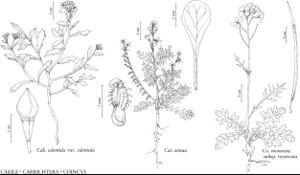Coincya
Naturaliste, sér. 2, 13: 248. 1891.
Annuals [biennials or perennials]; not scapose; glabrous or hispid. Stems usually erect, rarely prostrate, [unbranched] branched basally. Leaves basal and cauline; petiolate; basal rosulate, blade margins lobed, pinnatipartite to lyrate, or 1-pinnatisect or 2-pinnatisect, [entire or dentate]; cauline blade similar to basal, (base not auriculate). Racemes (corymbose), greatly elongated in fruit. Fruiting pedicels usually ascending to patent [reflexed], rarely erect, slender. Flowers: sepals erect, connivent, obtuse [narrowly oblong], lateral pair usually saccate basally, (setulose proximal to apex); petals yellow (usually with dark-brown, maroon, or purple veins), obovate, claw differentiated from blade, (apex obtuse); stamens tetradynamous; filaments not dilated basally, slender; anthers linear, (base sagittate); nectar glands: lateral glands lobed, median glands usually absent. Fruits siliques, dehiscent, sessile or subsessile, segments 2, linear, torulose, terete; (terminal segment 1–6-seeded, indehiscent, ensiform to cylindrical, linear, smooth); valves each 3 (–5) -veined, glabrous; replum rounded; septum complete; ovules 4–100 per ovary; stigma capitate, 2-lobed. Seeds uniseriate, plump, not winged, subglobose [globose, oblong]; seed-coat (reticulate), slightly mucilaginous when wetted; cotyledons conduplicate. x = 12.
Distribution
Introduced; w Europe, nw Africa
Discussion
Species 6 (1 in the flora).
Selected References
Lower Taxa
"elongated" is not a number."thick" is not a number.
